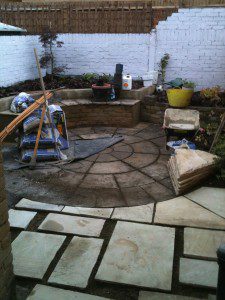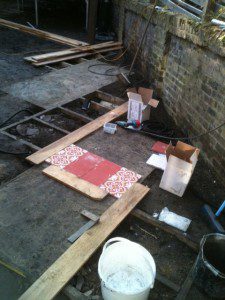Where do I begin designing my garden?

Before you really start to plan out your space stop and consider both the site and your circumstances. The practicalities of your finances, available time (both in constructing and maintaining the garden), the size of the space and what you want the finished garden to provide are all issues that should be the explored early in the design process to avoid wasted time and potentially costly mistakes when you start to make your vision a reality.
Size of the garden and it’s intended uses:
This sounds obvious, but be realistic about the amount of available space your garden has to offer. I have lost count of the number times I have sat in client consultations and been bombarded with a wish list for their garden which, if realised, would necessitate spreading on to their neighbours’ land and possibly also installing a mezzanine level for good measure. If you have a small town garden, it is extremely unlikely that you will be able to accommodate a swimming pool, hot tub, bike store, greenhouse, shed, outdoor kitchen, children’s playground, two patios and somewhere to grown veg. Just trying to cram a few of these things into a space that is too small could leave you with an overcrowded, disjointed and impractical space.
Even if you have a large plot, don’t be tempted to fill it with everything you’ve ever wanted from a garden. Consider splitting the garden up into distinct areas with specific uses, such as a dining area, utility area, play area, separated by screening, planting or pathways. And if you have never used a particular area of your grounds before, ask yourself why. Will I really walk down to the bottom of the garden to dispose of the compost? If the answer is no, have a rethink about where to put that bin.
The important question to ask yourself at this stage is what you actually need/want from your garden and what are ‘ideal world’ desires. If you haven’t ridden those bikes in the shed for the past 10 years maybe this is the time to sell them and free up some space. If you have always wanted a hot tub, let that rise to the top of the list. If you want a low maintenance garden and travel a lot, don’t set your mind on a vegetable garden as they can take a lot of attention to keep going. Is there a park nearby? If yes, then do your children really need a dedicated play area in the garden? Be selective – it will help your design no end if you slim down your requirements and are pragmatic about the limitations your plot.
Finances:
The bottom line is that gardens are expensive. Even if you intend to undertake all the landscaping work yourself, there are a lot of materials involved in constructing your average designed garden and these can be costly. With fuel prices continually rising, just getting your materials to site can cost hundreds of pounds. Be prepared that you are likely to spend thousands of pounds putting your garden together. And if you don’t have the confidence or time to build the garden yourself and intend to employ a professional landscaper to make your creative vision a reality then even a fairly conservative design could run to tens of thousands of pounds.
Before you start to get excited about the possibilities for your garden, take a careful look at how much you can afford to outlay. Spend some time researching the prices of the basic component features of a garden – such as paving, decking, lawn, pergola, storage unit – and take into account the true cost of installing them. Even if you find a there are great deals on a whole range of different paving slabs that would give you a good choice for your design, don’t forget to consider everything you will need to turn those slabs into a patio. How much sand and cement will you need? What will be the cost of disposing of the excavated waste? Will the slabs need sealing? What kind of base is required? The internet can be a great help here – both for cost comparisons and for installation guides that will give you the full picture of what materials are necessary to complete the job. Don’t be afraid to actually speak to suppliers and local builder’s merchants for advice and to haggle for the best deal you can manage.
By deciding on a fixed budget and spending a little time researching just what you can get for your money, you are less likely to run out of cash and end up with a half-finished garden. Also, concentrate on the main features of the garden before getting into the finishing touches. Plan your budget to prioritise the floor surfaces (patio, lawn, etc) and plants over furniture and ornaments. That way you will still have a useable space even if you have to save up for that luxury sundial, funky swing seat or state-of-the-art outdoor kitchen you have got your eye on.
Implementing the design – time management and skill set:
Another important consideration before you start to put your drawing pen to paper is how you are going to get the garden built. Not only is garden building expensive, it can also be time consuming. A professional, experienced landscaper with all the correct tools and a labouring team might expect to spend up to 4 – 6 weeks on an average build, especially considering the vagaries of the British weather. For a relatively inexperienced layman with basic tools working only at weekends (i.e. you) the project could take many months to complete and might be an unusable building site until quite near the end.
When considering just how complicated you want to get with your design ask yourself how much spare time you have and how long you are prepared to be without a usable garden. Just as you don’t want to run out of money and be left with a half finished space, equally you don’t want to lose drive and enthusiasm and end up seeing the garden as a chore rather than an exciting undertaking. Consider budgeting to get the more skilled and labour intensive aspects of the build, such as paving or raised beds, completed by a professional while you concentrate on the more user–friendly jobs such as planting, painting, simple woodwork and furnishing.
Maintenance
When deciding exactly what features your garden will contain, you will also need to think about its ongoing maintenance. How much time in your everyday life will you have to devote to keeping your expensive, lovingly crafted investment looking as good as the day it was made? If you work long hours, or have family or hobbies towards which you devote much of your time, then you will probably want to keep your design fairly low maintenance. Certain types of paving will need cleaning more often than others, cheaper softwood decking may need staining annually, and lawn will need regular mowing, feeding and watering (at least once or twice a month) in the spring and summer months to keep it looking lush and healthy.
If you can find and afford the services of a decent regular gardener (in London this can be easier said than done), or have plenty of time on your hands, then a low maintenance garden need not be so much of an issue. Otherwise, choose reasonably maintenance-free materials – sandstone or slate instead of creamy travertine paving, artificial lawn, self-sufficient plants such as bamboo, evergreen shrubs and architectural plants such as phormium – to ensure your garden remains attractive with the minimum of work on your part. If you are unsure, speak to the supplier of a material or plant to determine how much on-going work it will need – they will usually be happy to advise.



